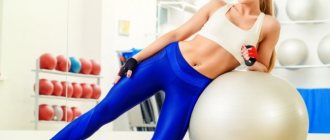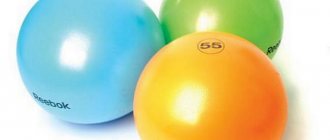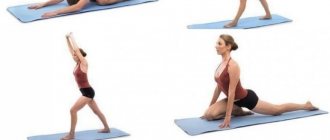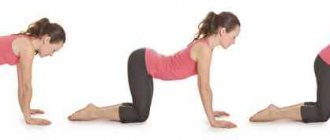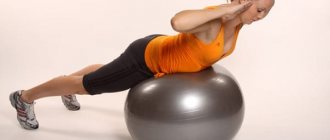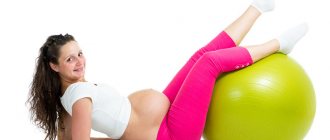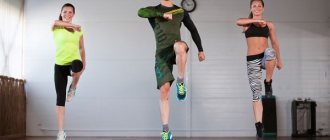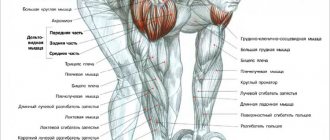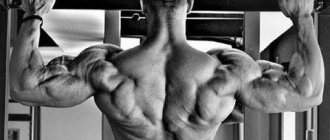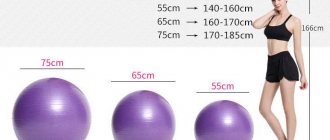Among the training devices for physical therapy, the gymnastic ball, or fitball, is becoming increasingly popular. The simulator is used both to maintain muscle tone and for rehabilitation after injuries, for the prevention and treatment of diseases of the back and spine. They will teach you how to properly perform exercise therapy with a fitball through video lessons and sessions with a personal trainer, as well as basic knowledge about such training.
What is fitball?
A fitball is an elastic, large-diameter exercise ball made of heavy-duty PVC and inflated with air. This type of sports equipment is also called orthopedic or Swiss - after the place of its invention. The idea was developed in the mid-twentieth century by pediatric physiotherapist Susan Kleinvogelbach, who was involved in the rehabilitation of children with cerebral palsy. Since the 60s, the invention has been used throughout the world. And two decades later, the American doctor Joan Posner Mauer included exercises with a fitball in the rehabilitation program for patients after injuries to the musculoskeletal system, and the ball began to be used in physical therapy. Later, the popularity of this simulator increased and it spread throughout the world.
Fitball translated from English is a combination of the words “slimness” and “ball”: and the name exactly matches the content. This is an effective exercise machine that is accessible to everyone, which you can simply deflate and put on a shelf and easily take with you on the road! In the manufacture of this projectile, Anti-Burst System technology is used, which prevents the ball from bursting: as a result, it can withstand a load of up to 300 kg!
People paid attention to the possibilities offered by a gymnastic ball - a universal, inexpensive sports equipment, and began to use it for exercise not only in gyms and rehabilitation centers, but also at home. Training with a fitball strengthens the muscle corset, helps recover from injuries, lose weight, get rid of cellulite, and develop dexterity and coordination of movements.
The peculiarity of exercises with a ball is the simplicity and effectiveness of their use, which allows this apparatus to be used by people of all ages, gender and health status. And one more important positive point: with all its advantages, fitball is affordable for anyone - both a student and a pensioner. And in terms of popularity, gymnastic balls can compete with dumbbells or expanders.
Attention! A fitball should not be confused with a medicine ball - a medicine ball. The latter has small dimensions, weight - from 1 to 12 kg and is used as an alternative to weights or dumbbells.
Types of gymnastic balls
Despite the simplicity and versatility of gymnastic balls, they have several varieties. Fitballs differ in color, diameter, hardness and texture. The diameter of the Swiss ball ranges from 45 to 95 centimeters and is selected in accordance with the needs and individual characteristics of the person. Stiffness depends on the degree of inflation of the ball and the density of the material from which the fitball is made. Swiss balls are divided into several categories based on their texture.
- Smooth.
This is a universal type of fitball; it can be seen more often than others in gyms. Such equipment is used for relaxation, relaxing the back muscles, and strengthening the abs. - Hoppers are balls with horns.
Recommended for children and pregnant women. It is easier to maintain balance on a ball with handles while performing exercises. - Studded (with pimples).
This is a massage type of fitball: exercises with it accelerate the blood and have an anti-cellulite effect.
This is interesting! The color of the fitball is not particularly important, however, if you choose a ball of your favorite shade, there will still be benefits: scientists have proven that our body and psyche are sensitive to the color spectrum. For example, blue tone calms, red adds energy, green relieves fatigue, and pink and yellow colors improve mood and drive away depression.
Main characteristics
When choosing and purchasing an elastic ball, you need to study its features and characteristics. The following indicators require the most attention:
- sufficient elasticity. When you lightly press the surface, the ball should spring back;
- strength;
- Smooth surface. If the ball is of high quality, the seams should not be visible;
- possessing antistatic properties;
- tightly inserted nipple that reliably holds air inside;
- no unpleasant odor from the ball.
In order to purchase gymnastic equipment that suits your diameter, you need to know your exact height. The values of this indicator are divided into four groups: up to 155 cm, from 155 to 169 cm, from 170 to 185 cm, and finally, 186 cm and above; for each of the groups, the ball diameter is 45, 55, 65, respectively. cm, and more than 75 cm.
To understand that the model you have chosen will fit perfectly with your build, you can take the following position: sit on top of the ball, and in this position make sure that the angles between the thigh and the straightened torso, lower leg and foot placed on the floor are straight, that is, approximately 90 degrees .
This equipment should be used on a flat, smooth surface, this will avoid accidental mechanical damage. If you were unable to avoid a puncture, do not rush to go to the store for a new ball; there is always the opportunity to repair the damage. Often the product comes with glue, which can be used to solve this problem.
The maximum weight load allowed on a fitball is indicated in the description of the technical characteristics of the model. Typically, quality products can withstand the weight of even the largest athlete. The maximum load in most models is from 200 to 300 kg.
We advise you to study - Basic massage techniques for hernia of the lumbar spine
The benefits of exercising on a fitball
The peculiarity of the fitball, which makes it universal, is that during exercises with it the motor, vestibular, visual and tactile apparatuses are simultaneously involved in the work. Exercises with balls are safe and fun. But the most important thing is the undeniable benefits of exercising with fitball for the body. What effect can you get by working with a gymnastic ball?
- Correct posture. Any exercise with a ball strengthens the back muscles without overstraining them. Due to the need to maintain balance, the work includes types of muscles that are not used in other types of training. The muscle corset around the back is strengthened.
- Training the vestibular apparatus - over time, the ability to maintain balance automatically is developed, and coordination of movements improves.
- Improving the functions of the cardiovascular system and respiratory system by activating blood supply.
- Strengthening the nervous system. Fitball exercises lift your spirits, help you relax and relieve stress.
- Development of flexibility and plasticity. During the exercises, all muscles are warmed up, joints are unloaded and stretched, and clamps are removed.
- Accelerates metabolism and burns fat. Comprehensive exercise programs with a fitball help you lose excess weight. For women, the benefit of training is the opportunity to get an ideal sculpted figure, beautiful abs, elastic buttocks, and remove fat deposits from the hips.
On a note. To get the first benefit from a Swiss ball, you just need to sit on it: this already “works” for beautiful posture! In Scandinavian countries, many people use this ball instead of a chair. This is such an unobtrusive benefit. And if you also jump lightly on the fitball, the release of serotonin, the hormone of happiness, into the blood will ensure a good mood.
Back strengthening tactics
Before we talk about how to exercise on a fitball, what exercises there are for this, and how to do them, let’s look at one point.
Strengthening your back consists of two components: working with the abs and working with the back muscles.
The vertical position of the body is maintained due to the balanced tension of the abdominal and back muscles. If one side is stronger than the other, there will certainly be poor posture, chronic stoop, and headaches.
To prevent all this from happening, your back needs to be trained in parallel with your abs. Both can be strengthened with a fitness ball.
Who is fitball training suitable for?
Age, physiological characteristics, excess weight and fatigue are not a hindrance to exercise with fitball. Balls are used in gyms and rehabilitation centers, and at home. Fitball training is suitable for everyone who cares about their health. Exercises with a gymnastic ball are needed:
- for regular training to strengthen the body, muscles, lose weight, improve posture, figure, and general well-being;
- for pregnant women: training prepares muscles for childbirth, relieves tension from the lower back, improves blood circulation;
- for children of any age - to train endurance, strengthen muscles, coordinate movements;
- for newborns, starting from the 2nd week of life - to strengthen the vestibular apparatus, relieve muscle hypertonicity, improve blood circulation;
- for older people to improve tone, improve coordination, blood circulation;
- during the rehabilitation period when recovering from injuries;
- as a relaxation and anti-stress therapy after a hard day.
The Swiss ball is even used in maternity hospitals: swinging on the fitball and rolling it from side to side relieves pain during contractions. Many pediatricians recommend rocking the baby while bouncing on a ball: this simultaneously calms the baby and massages the mother’s lower back muscles.
Requirements for beginners
List of rules for practicing on the ball:
- Comfortable clothes and shoes.
- Long hair in a bun or ponytail.
- Quiet and spacious room, without strangers.
- Mandatory 15-minute warm-up before main exercises.
- Yoga no more than 30 minutes to begin with (not including warm-up).
- Fitball according to recommended size: taken into account depending on height.
- A glass of water near the training area. You cannot leave the comfortable state of peace and quiet room.
- It is advisable to turn on a relaxing and monotonous melody.
Before training, be sure to drink water and leave breakfast for later. After home practice, you should take a contrast shower to speed up your metabolism and turn on your metabolism.
Harm and contraindications
Although the benefits of exercises with a gymnastic ball are undeniable, there are certain periods and human conditions when training with a fitball is not recommended. You should not take risks in the first trimester of pregnancy, especially if the uterus is hypertonic and there is a threat of miscarriage. You cannot perform exercises with a ball if you have severe spinal injuries, including intervertebral hernia. People suffering from cardiovascular diseases or serious pathologies of internal organs should consult a doctor about exercising with a fitball.
A set of exercises for the lower body
Now let's talk in more detail about exercises on this miracle ball. One of the main exercises in this series is squatting with a ball over your head. This is a regular squat, but with your arms extended upward and holding a huge ball. This exercise perfectly strengthens the muscles of the arms and legs.
The next type is a squat with emphasis on the wall. The fitball is squeezed between the wall and the body. During squats, it rolls along the back from bottom to top - from the lower back to the shoulders. This is how the quadriceps muscle is trained. The exercise, like the previous one, must be repeated 10-15 times.
Exercises of this type include: squats with a fitball clamped between the knees, slow squats with arms extended forward holding the ball, lunges, etc.
If the descriptions of the classes are not enough, you can watch video exercises on a fitball. They will show you all the details.
How to choose a fitball?
The effectiveness of exercises with a fitball depends not only on the intensity of the exercise, but also on the correctly chosen size of the ball. It will be inconvenient to exercise with a small one, and with a large fitball there is a high probability of falling and getting injured. There are two options for choosing a projectile.
- Sit on the ball with your legs together in front of you, back straight. The inclination of the knee joint should ideally be 90⁰, maximum 110⁰. If the slope is an acute angle, the ball is too small for you.
- If it is not possible to “try on” the ball, and the purchase is made remotely, focus on the following parameters:
- for newborns, children, teenagers and adults up to 1 m 52 cm, a ball 45 cm in diameter is recommended;
- people with a height from 1 m 52 cm to 1 m 64 cm - 55 cm;
- with a height from 1 m 64 cm to 1 m 80 cm - the diameter of the ball is 65 cm;
- if an athlete is taller than 1 m 80 cm, buy a 75 cm fitball;
- For those who are taller than 1 m 90 cm, balls with a diameter of 85 cm or more are suitable.
For gym workouts, choose a classic smooth ball. Beginners, children and pregnant women should purchase a fitball with “horns” for greater confidence. The “pimply” massage device works more deeply with the muscles: it is good for combating cellulite and neurological pathologies.
Important! When choosing a fitball, you need to pay attention to the maximum weight it is designed for. In addition, the ball should not be too elastic or soft, the effectiveness of the exercise depends on this - the degree of its inflation should be adjusted.
The cost of gymnastic balls depends on the diameter of the projectile, material of manufacture, modification and brand of the manufacturer. On average, this ranges from 700 rubles for the smallest ball and up to 1800-2000 for fitballs of large diameters.
Exercise during pregnancy
The complex is aimed at relieving tension in the lower back, strengthening the back muscles, which will facilitate the process of bearing a child.
- Sitting on top of the ball, keep your back straight, head up, and shoulders down. Raise your arms parallel to the floor, keep them at the same level. Bend your left arm, press your elbow to your body and point it back. The position is reminiscent of pulling the string of a bow. Repeat similarly for the right hand.
- Sitting on top of the fitball, stretch your spine, arms should be bent at the elbows, elbows pressed to the body. Without lifting your elbows from your body, spread your forearms and keep them parallel to the floor. Try to squeeze your shoulder blades together more, hold for 2-3 seconds, and take the starting position.
- Keep your back straight while sitting on the fitball, extend your arms, keeping them parallel to the floor. Lower your body down to an angle of 60-45 degrees to the floor, while keeping your arms bent at the elbows. Bring your shoulder blades together without lifting your shoulders. In this position, straighten your arms while inhaling. Bend your arms while exhaling and straighten up.
- Sit on your knees, tilt your body at an angle of 45-60 degrees, rest your palms on your hips. Bend your arms, point them to the sides, tilt your body lower. You need to connect your shoulder blades, lower your shoulders, and return to the original position.
- For the exercise you will need another ball, smaller in size. Sit on the floor, turning your back to the ball, press the back of your head and shoulders, hold the small ball with your feet, spread your knees to the sides. Place your hands behind your head, fold them so that your forearms are connected. Relaxing as much as possible, hold in this position for about 2 minutes.
If discomfort occurs, experts advise placing a blanket or fitness mat under the buttocks.
Find out: how to make a back exercise machine with your own hands
I can talk endlessly about the benefits of exercises with a fitball for the back. Therefore, choose the exercises you like, perform them regularly, then your back will always be in good shape and your health will be excellent.
A set of exercises for the spine
To solve back problems, you need to perform the following exercises daily:
Lie down on the fitball, with the main emphasis on your chest, resting your feet against the wall. Your arms should be bent, your palms should be placed on the ball, and your elbows should be spread to the sides. Raise yourself upward as you inhale, resting on the surface of the equipment. When exhaling, return to the starting position. Repeat 8 times. Take the same position, turning your head first in one direction and then in the other, while trying to see your feet. Repeat 4 times. Lie on the fitball, straightening one arm forward as you inhale, and the other back. While exhaling, change the position of your hands. Repeat 15 times. Lie stomach down on a fitball with your limbs down
It is important to completely relax the body, allowing the spine to stretch as much as possible. You should remain in this position for about 30–40 seconds, then group and repeat the exercise again.
Grasping the ball with your hands, kneel down and pull yourself up without loading your spine. Repeat 8 – 9 times.
